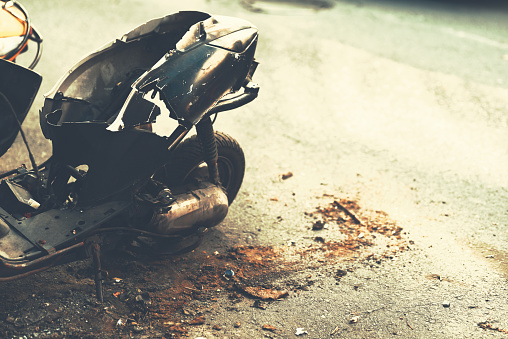
A 20-year-old Bensonhurst man is dead after he smacked into an abandoned, double-parked restaurant delivery truck on 86th Street in Gravesend.
The wreck happened shortly after 4 a.m. in an area where multiple delivery trucks are often double-parked. It’s unclear whether the delivery truck driver was cited or not. The 20-year old man was already the fourth fatal car crash victim in New York City. Therefore, 2022 is on pace to shatter the record-breaking 2021 fatal accident numbers.
The rider died at the scene. Emergency responders rushed a moped passenger to a nearby hospital with serious injuries.
Moped Accident Injuries
Riding a moped won’t make you tough enough to get into the Salty Spitoon. It might not even make you tough enough to get into the Weenie Hut. But mopeds are an excellent and fuel-efficient way to get around in dense urban areas, like Brooklyn. Gas or electric scooters are also very dangerous.
Moped riders, like motorcycle riders, are largely unprotected during crashes. Unlike motorcycle riders, moped riders usually can’t keep pace with other vehicles on the road. So, these riders face all the injury risks that motorcyclists face, yet they have none of the benefits. Some of these serious injuries include:
Most moped accident victims are never the same physically after a wreck. They’re usually never the same mentally either. The emotional injuries, like Post Traumatic Stress Disorder, are usually permanent, at least to an extent.
First Party Liability
At first blush, the wreck in the above story seems to be an open and shut negligence case. But upon closer inspection, a New York personal injury attorney would have a hard time obtaining maximum compensation under either traditional liability theory.
Ordinary negligence is basically a lack of reasonable care. Double parking and abandoning the vehicle, even for a brief period of time, is clearly a breach of duty. Responsible drivers, especially responsible commercial drivers, cannot behave this way under New York law. Furthermore, the breach of care clearly caused injury.
However, all drivers, including moped riders, have a duty of reasonable care at all times. So, the moped rider had a duty of care to watch the road and avoid accidents if possible. The comparative fault defense, which is discussed below, often comes into play in these situations.
Negligence per se is another possibility. It’s illegal to double park in New York City and most other places in the Empire State. If a safety law violation causes injury, the ticketed driver could be responsible for damages as a matter of law. The aforementioned duty of reasonable care is irrelevant, since in this case, a safety law establishes the standard of care.
But, did the double parking “cause” the above wreck? Or, did the moped rider’s negligence cause this wreck? Once again, we’ll dive into this question when we discuss comparative fault below.
Here’s the bottom line. Almost any New York personal injury attorney could probably establish a prima facie (preliminary) negligence case. The basic elements of both ordinary negligence and negligence per se are present. But only a good lawyer could obtain maximum compensation for a victim, because the insurance company’s legal defenses are very strong.
Compensation in a vehicle collision matter usually includes money for economic losses, such as medical bills, and noneconomic losses, such as pain and suffering.
Third Party Liability
Legal responsibility is often a tough nut to crack in a car crash case. Financial responsibility is usually more straightforward. The respondeat superior doctrine usually applies in delivery driver, taxi driver, Uber driver, and other commercial operator crash cases. Employers are financially responsible for damages in these situations if:
Establishing driver negligence is the tricky part. Obviously, employers are only liable for damages if the driver was at least mostly responsible for the wreck.
Other third party liability theories include negligent entrustment owner liability. An individual owner is liable for damages if s/he knowingly allows an incopenent operator to get behind the wheel of his/her vehicle. Commercial negligent entrustment cases, like U-Haul truck wrecks, are rather complex, because of the federal Graves Amendment and New York’s vicarious liability law.
The Contributory Negligence Defense
Striking a parked vehicle, or a parked beast of burden, is a classic contributory negligence scenario. In an 1842 case, Davies v. Mann, a man let his donkey take a break and graze on the side of a road. The defendant’s three-horse wagon came down a hill at a “smartish pace,” according to a witness. Then, the wagon “ran against the ass, knocked it down, and the wheels passing over it, it died soon after.” The court determined that both proto-motorists were at fault for this crash.
Roughly the same division of responsibility would appear to apply in the above case. The delivery driver should have parked legally and the moped rider should have watched the road. But not so fast. Did you notice this accident occurred at four in the morning? Did you also notice that lots of delivery trucks double park in this area? In other words, the moped rider’s visibility was probably limited and the delivery driver probably thought it was no big deal to double park. These additional facts could tilt the division of responsibility in the victim’s favor.
Injury victims are usually entitled to substantial compensation. For a free consultation with an experienced personal injury attorney in New York, contact the Pianko Law Group, PLLC. You have a limited amount of time to act.